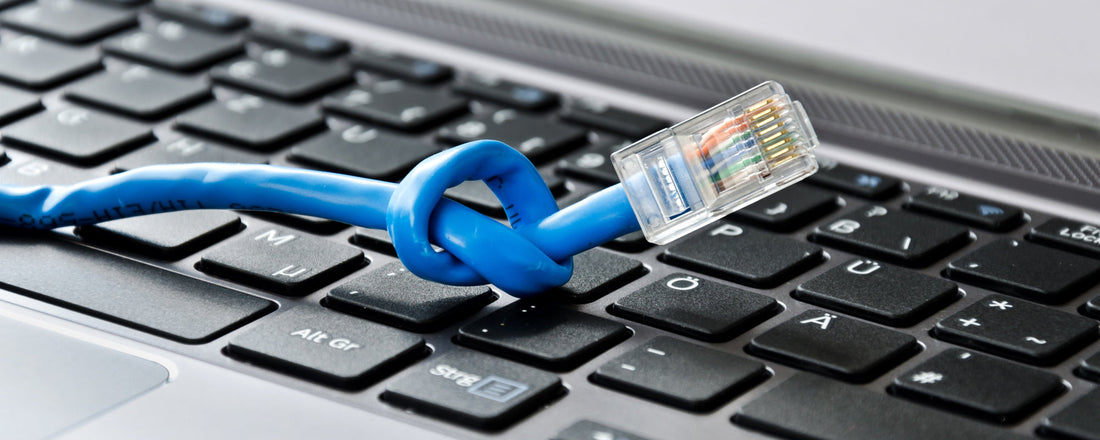
WHAT TO DO IN CASE OF INTERNET OUTAGES? TROUBLESHOOTING AND PROBLEM SOLVING
Share
 A sudden loss of internet connection can be frustrating – especially when working from home, making an important video call, or accessing streaming services. However, not every internet outage has the same cause.
A sudden loss of internet connection can be frustrating – especially when working from home, making an important video call, or accessing streaming services. However, not every internet outage has the same cause.
We’ll show you what to do in the event of an internet outage, how to systematically narrow down the problem, and what rights you have with your provider.
First Aid for Internet Outage: Here's What to Do
Before picking up the phone to contact your internet provider, you should carry out some basic troubleshooting steps. Often, the problem can be resolved quickly by yourself.
1. Check the Router and Cabling
- Check whether the router providing your internet access is properly powered.
- If LEDs are red or not lit at all, a fault may be present.
- Unplug the router, wait at least one minute, then plug it back in (restart).
- Check all cable connections for a secure fit and visible damage.
- Access your router’s interface (e.g., “fritz.box” or “speedport.ip”) to check the connection status.
2. Test the Connection to the End Device
- Ensure your computer, smartphone, or tablet is correctly connected to the Wi-Fi network.
- Alternatively, use a LAN cable to rule out Wi-Fi issues – often, the problem lies with the wireless network rather than the internet connection itself.
- Try the connection on a second device. If it doesn't work there either, the issue likely isn't with the device.
- Temporarily disable any VPN connections, as these can cause connection problems.
3. Check DNS Settings
- For advanced users: Sometimes changing the DNS server helps. Use e.g. 8.8.8.8 (Google) or 1.1.1.1 (Cloudflare).
- Manually enter these servers in your device’s network settings.
4. Wi-Fi Optimization for Unstable Connections
- Place the router as centrally as possible within your home.
- Avoid obstacles such as walls, metal furniture, or microwaves.
- Use Wi-Fi repeaters or a mesh system if needed.
- Regularly update your router’s firmware.
- Change the channel settings if your network is being interfered with by another network or signal.
Identifying Provider-Side Issues: Here's What to Do
If your local equipment is in order, a larger network outage may be the cause. It’s worth checking relevant information services in such cases.
Use Outage and Monitoring Services
- On platforms such as www.allestoerungen.de, you can see if other users in your region are also experiencing internet problems.
- Many providers have their own outage pages, such as Telekom, Vodafone, 1&1, or o2.
- Heise also offers an overview of current internet outages in Germany via the iMonitor.
- If these platforms report an outage in your region, there’s nothing to do but wait.
Contacting Your Internet Provider
If there is no widespread outage, you should report an individual fault to your provider.
- Have your customer number ready; a phone PIN is often also required when calling.
- Describe the problem as accurately as possible (e.g., type of connection, when the problem occurred, which LEDs are lit on the router).
Example Hotlines of Major Providers:
- Telekom: 0800 33 01000
- Vodafone: 0800 1721212
- 1&1: 0721 9600
- o2: 0800 5251378
Your Rights During Internet Outages According to the Telecommunications Act (TKG)
The revised TKG grants you strong rights in the event of prolonged outages:
- The provider is obligated to fix issues promptly and free of charge.
- If no resolution occurs within one day, the provider must inform you about actions taken and the estimated duration.
- If the outage persists for more than three calendar days, you are entitled to compensation:
- 5 euros or 10% of your monthly fee per day (whichever is higher).
- In the event of repeated or ongoing outages, you may have the right to terminate the contract early.
Additional Tips and Tools for Internet Issues
- Use the Broadband Measurement Tool by the Federal Network Agency to document your actual internet speed.
- Consider switching providers in case of frequent issues.
- For emergencies: Many mobile providers offer LTE or 5G home spot solutions.
Questions and Answers About Internet Outages
Is My Connection Experiencing an Outage?
You can recognize this through the following indicators:
- Red or blinking LEDs on the router
- No access to websites despite an active Wi-Fi connection
- No signal according to the router menu
- Confirmations from outage pages like allestoerungen.de or in the provider’s customer portal
How Quickly Are Outages Resolved?
- Troubleshooting should begin within 24 hours.
- If it takes longer, the provider must keep you informed.
- Full resolution may take from a few hours to several days, depending on the cause.
How Do I Report an Outage?
- Most quickly via phone through your provider’s hotline
- Alternatively via app, customer portal, or contact form
- Describe the problem as precisely as possible (What works? Since when? Which LEDs are on? What steps have you already taken?)
What If the Provider Doesn't Respond?
- Document your contact attempts and the timeline.
- Use the Federal Network Agency's complaint form.
- Consider contacting a consumer protection agency or switching providers.
Conclusion: Well Prepared for Internet Outages
An internet outage is annoying, but with systematic troubleshooting, it’s often quickly resolved. If local causes are ruled out, monitoring portals and provider contact can help. Thanks to legal regulations, you’re also entitled to compensation for extended outages. With the right tools and a bit of technical understanding, you can stay in control during disruptions and know exactly what steps to take.
